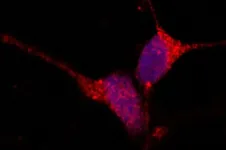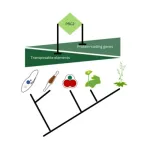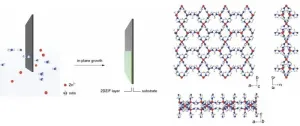(Press-News.org) Under normal circumstances, tau protein is part of the brain’s infrastructure, important for stabilizing neurons into their proper shapes. But sometimes tau gets knotted up into tangles and turns toxic, injuring brain tissue and causing tauopathies, a group of brain diseases characterized by problems with learning, memory and movement. Alzheimer’s disease is the most common tauopathy, but the group also includes Parkinson’s disease, chronic traumatic encephalopathy (CTE) and several rare genetic conditions.
In search of ways to prevent these destructive tau tangles, researchers at Washington University School of Medicine in St. Louis have identified a key step in their development. Intervening at this step potentially could forestall the destructive cascade of events that results in brain damage, the researchers said. The findings are published Sept. 20 in the journal Molecular Psychiatry.
“Tauopathies are devastating diseases that have limited treatment options right now, and they all have this feature of tau aggregation,” said senior author Celeste Karch, PhD, a professor of psychiatry. “We’ve been thinking for a long time about whether there are factors that impact that common process of tau aggregation and if so, whether we could target those factors as a novel approach to treatment. These findings move us one step closer to finding a way to intervene and stop the process of tau aggregation that leads to dementia.”
First author Reshma Bhagat, PhD, a postdoctoral researcher, came up with the idea of looking for such factors among a group of RNA molecules known as long noncoding RNAs (lncRNAs) that are not translated into proteins. Historically, RNA has not been considered an active element in biological processes, and most disease research has not focused on them. Only in the past decade have scientists recognized that these RNA molecules can play critical roles in disease processes. Bhagat became interested in lncRNAs because they are involved in regulating diverse cellular processes and have been implicated in cancers.
To investigate the role of lncRNAs in tauopathies, the researchers started with skin cells from three people with a genetic tauopathy, each of whom carried a different mutation in the tau gene. Using molecular techniques, the researchers converted the skin cells into brain neurons that carry each of the three mutations. For comparison, they used a molecular technique known as CRISPR to correct the mutations in some of the skin cells before converting them into neurons. In this way, they were able to obtain human brain cells with and without tau mutations, which didn’t require using human brain tissue.
Using these cells, the researchers identified 15 lncRNAs that were significantly increased or decreased in brain cells with tau mutations compared to their genetically matched controls. One lncRNA in particular stood out: SNHG8, which was low not only in the three human brain cells with tau mutations but also in mice with a tau mutation and in brain samples from people who had died of any of three different tauopathies: Alzheimer’s disease, frontotemporal lobar degeneration with tau pathology, or progressive supranuclear palsy. In other words, SNHG8 levels were down in tauopathies regardless of mutation, species or disease — all signs that point to its role in a common pathological process.
Further investigation revealed that neurons with low SNHG8 levels also had high levels of stress granules, RNA-protein complexes that form to help cells survive stressful situations such as excessive heat or low oxygen and disintegrate once the threat passes. Stress granules are rich in tau, and therein lies the danger. If too many stress granules form or if they contain mutated tau particularly prone to tangling — as is the case in genetic tauopathies — stress granules can kickstart the aggregation process by concentrating tau.
“If we could somehow target this stress-induced protein-aggregation pathway, maybe we can inhibit the development of tau pathology,” Bhagat said.
Bhagat went back to the human neurons with tau mutations, the ones she had developed out of skin cells from tauopathy patients. These cells exhibited persistently low levels of SNHG8 and high levels of stress granules. By replacing the missing SNHG8, she was able to bring down the levels of stress granules in such cells.
“That’s really the killer experiment,” Karch said. “That shows that lncRNAs are impacting stress granule formation and that this pathway can be targeted to treat, potentially, a variety of tauopathies.”
Bhagat, Karch and colleagues are working on identifying compounds that can shore up SNHG8 levels and looking at the effects of such compounds in animal models of tau aggregation and tauopathy.
END
How do toxic proteins accumulate in Alzheimer’s and other diseases?
Key steps leading to such accumulation identified; could inform new therapeutic approaches
2023-09-21
ELSE PRESS RELEASES FROM THIS DATE:
Study details immune cells vital to success of vaccines against coronavirus
2023-09-21
A study has revealed new details about a key population of immune system cells critical to successful vaccination against the pandemic virus, SARS-CoV-2.
Led by researchers at NYU Grossman School of Medicine and New York Genome Center, the current study focused on T cells, which along with B cells, compose the human immune system’s response to invading viruses and bacteria. A subset of T cells, labeled with the surface protein CD8, produce molecules that directly kill infected cells. B cells produce antibody proteins that neutralize and label infected cells for removal from the body.
Without risking ...
University of Cincinnati research examines the molecular mechanism of psychological loss
2023-09-21
Psychological loss can occur when someone loses a job, loses a sense of control or safety or when a spouse dies. Such loss, which erodes well-being and negatively impacts quality of life, may be a common experience but little is known about the molecular process in the brain that occurs because of loss.
New research from the University of Cincinnati explores those mechanisms through a process known as enrichment removal (ER). The study highlights an area of the brain that plays a key role in psychological loss and identifies new molecular targets that may alleviate its impact.
The research was published in the journal Molecular Psychiatry.
The research was led by Marissa Smail, a ...
Cardiff University chooses Figshare as integral part of research data management strategy
2023-09-21
Digital Science, a technology company serving stakeholders across the research ecosystem, is pleased to announce that Cardiff University has chosen Figshare from Digital Science’s flagship products to enhance its researcher support services, as it continues its work as a leading research institution.
Cardiff University – already excelling in the production of high-quality, innovative research that translates into benefits for the city, Wales and worldwide – has signed a two-year deal to utilize Figshare as its data repository and to form an integral ...
MD Anderson Research Highlights for September 21, 2023
2023-09-21
HOUSTON ― The University of Texas MD Anderson Cancer Center’s Research Highlights showcases the latest breakthroughs in cancer care, research and prevention. These advances are made possible through seamless collaboration between MD Anderson’s world-leading clinicians and scientists, bringing discoveries from the lab to the clinic and back.
Understanding the role of exceptional research as a driving force behind progress in its mission to end cancer, MD Anderson is proud to support World Cancer Research Day, Sept. 24, which calls for global efforts to promote cancer ...
Incidence of diabetes among youth before and during the pandemic
2023-09-21
About The Study: In this study that included data from Kaiser Permanente Southern California of individuals age 19 and younger, the incidence of type 1 diabetes slightly increased overall and type 2 diabetes significantly increased after the beginning of the COVID-19 pandemic, in particular among non-Hispanic Black and Hispanic youth. These findings suggest the need for further evaluation of physiologic and behavioral risk factors preceding new-onset diabetes during the pandemic.
Authors: Matthew T. Mefford, Ph.D., of Kaiser Permanente Southern ...
Disparities in emergency medicine residents’ performance assessments by race, ethnicity, and sex
2023-09-21
About The Study: This analysis of assessments of 2,708 emergency medicine residents found evidence of sex-specific ethnoracial disparities in ratings on the Milestones assessments. These disparities increased over time across multiple Milestones assessments and were most severe for female residents of ethnoracial groups that are underrepresented in medicine.
Authors: Elle Lett, Ph.D., M.A., M.Biostat., of the University of Washington School of Public Health in Seattle, is the corresponding author.
To ...
New origin story for key regulatory gene
2023-09-21
Polycomb repressive complex 2 (PRC2) was discovered decades ago in Drosophila, where it was found to be a key controller of developmental genes. Further analyses showed that PRC2 modifies chromatin and silences target gene expression. However, the ancestral function of PRC2 - as functioning primarily to control genes during development - was called into question when researchers discovered that PRC2 also plays a role in unicellular species, in which no development takes place. A first hint at PRC2’s original role came from studies in red algae, which found PRC2 left its methylation mark on transposons – jumping genes that ...
Ultrathin films achieve record hydrogen-nitrogen separation
2023-09-21
Metal-organic frameworks (MOFs) are a class of materials that contain nano-sized pores. These pores give MOFs record-breaking internal surface areas, which make them extremely versatile for a number of applications: separating petrochemicals and gases, mimicking DNA, producing hydrogen, and removing heavy metals, fluoride anions, and even gold from water are just a few examples.
In the gas-separation domain, MOFs are particularly interesting for separating hydrogen from nitrogen, which is crucial for clean energy production, fuel cell efficiency, ammonia synthesis, and various ...
Getting ready for bed controlled by specific brain wiring in mice
2023-09-21
The team, led by Imperial College London researchers, uncovered the wiring in mouse brains that leads them to begin nesting in preparation for sleep. Published today in Nature Neuroscience, the study reveals that preparing properly for sleep is likely a hard-wired survival feature – one often neglected or overridden by humans.
We all need to sleep, but since we are unconscious when we do so, it makes sense to fall asleep in a safe and warm place. For some animals this is especially important, as a burrow or nest provides a haven from ...
Mutation-specific peptide vaccine against midline gliomas used in patients for the first time
2023-09-21
Tumor vaccines can help the body fight cancer. These vaccines alert the patient's immune system to proteins that are carrying cancer-typical alterations. Physicians and cancer researchers from Heidelberg and Mannheim have now treated adult patients with advanced midline gliomas, difficult-to-treat brain tumors, with a peptide vaccine for the first time. The vaccine mimicked a mutational change in a histone protein typical of this type of cancer. The vaccine proved to be safe and induced the desired immune responses directed ...
LAST 30 PRESS RELEASES:
Eye for trouble: Automated counting for chromosome issues under the microscope
The vast majority of US rivers lack any protections from human activities, new research finds
Ultrasound-responsive in situ antigen "nanocatchers" open a new paradigm for personalized tumor immunotherapy
Environmental “superbugs” in our rivers and soils: new one health review warns of growing antimicrobial resistance crisis
Triple threat in greenhouse farming: how heavy metals, microplastics, and antibiotic resistance genes unite to challenge sustainable food production
Earthworms turn manure into a powerful tool against antibiotic resistance
AI turns water into an early warning network for hidden biological pollutants
Hidden hotspots on “green” plastics: biodegradable and conventional plastics shape very different antibiotic resistance risks in river microbiomes
Engineered biochar enzyme system clears toxic phenolic acids and restores pepper seed germination in continuous cropping soils
Retail therapy fail? Online shopping linked to stress, says study
How well-meaning allies can increase stress for marginalized people
Commercially viable biomanufacturing: designer yeast turns sugar into lucrative chemical 3-HP
Control valve discovered in gut’s plumbing system
George Mason University leads phase 2 clinical trial for pill to help maintain weight loss after GLP-1s
Hop to it: research from Shedd Aquarium tracks conch movement to set new conservation guidance
Weight loss drugs and bariatric surgery improve the body’s fat ‘balance:’ study
The Age of Fishes began with mass death
TB harnesses part of immune defense system to cause infection
Important new source of oxidation in the atmosphere found
A tug-of-war explains a decades-old question about how bacteria swim
Strengthened immune defense against cancer
Engineering the development of the pancreas
The Journal of Nuclear Medicine ahead-of-print tip sheet: Jan. 9, 2026
Mount Sinai researchers help create largest immune cell atlas of bone marrow in multiple myeloma patients
Why it is so hard to get started on an unpleasant task: Scientists identify a “motivation brake”
Body composition changes after bariatric surgery or treatment with GLP-1 receptor agonists
Targeted regulation of abortion providers laws and pregnancies conceived through fertility treatment
Press registration is now open for the 2026 ACMG Annual Clinical Genetics Meeting
Understanding sex-based differences and the role of bone morphogenetic protein signaling in Alzheimer’s disease
Breakthrough in thin-film electrolytes pushes solid oxide fuel cells forward
[Press-News.org] How do toxic proteins accumulate in Alzheimer’s and other diseases?Key steps leading to such accumulation identified; could inform new therapeutic approaches




